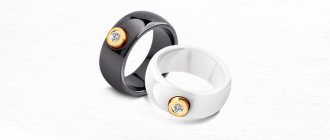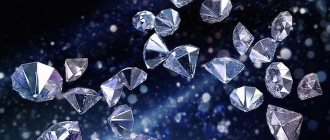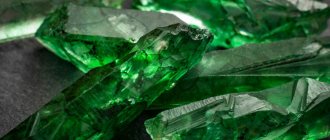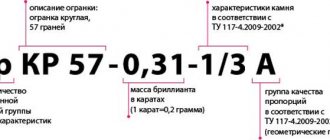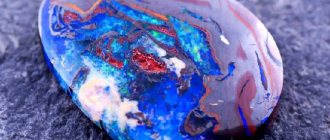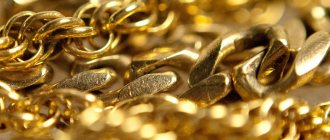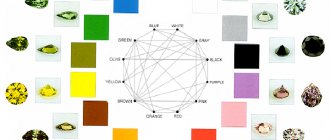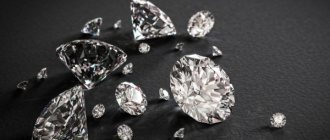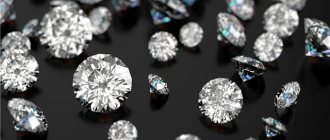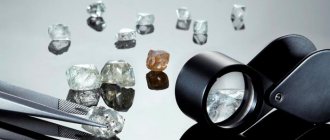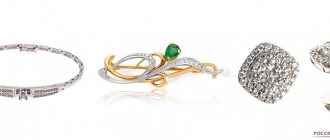Welcome again, our diamond readers! Precious minerals and jewelry have always attracted, and will continue to attract, attention for many years to come. Colorfulness, play in the world, uniqueness and rarity cause not only delight, but also admiration... and the price for them is amazing too. How is it formed? Why, for example, is this diamond lighter in weight, but costs several times more expensive compared to a larger one? After all, in theory, it should be the other way around. That is why we will consider such a topic as diamond valuation today.
We will try to convey to you the answers to your questions as easily and without routine as possible, share our knowledge and unusual facts. We are sure that reading the article will be interesting! Go!
Diamond grading systems
A unified classification of the main parameters of a diamond was not in demand until the 1950s. The stone remained the privilege of a few; a simple taxonomy of Old Term color was sufficient; the question of the purity of the crystal did not arise.
Diamond
However, after the film “Gentlemen Prefer Blondes” (1953) with Marilyn Monroe, where she sang a song about “a girl’s best friend,” diamonds became not just popular, but cult attributes.
Considering this circumstance, experts took up the problem closely. Ten years later, employees of the Gemological Institute of America (GIA) presented 4C. The system covers all the nuances that determine the value of a crystal: color, clarity, weight, cut.
Today, the GIA classification is the basis for determining the value of diamonds.
Classification of rough and polished diamonds GIA
Diamonds are assessed by national specialized institutions or certified specialists.
The Belgian High Diamond Council and the World Jewelry Confederation, headquartered in Switzerland, enjoy worldwide authority. Certificates issued by their laboratories are unconditionally recognized in all countries.
In Russia, all manipulations with cut diamonds are regulated by TU 117-4.2099-2002 “Diamonds. Technical requirements. Classification". The quality of the stone is assessed by several organizations, in particular, the Gemological Center of Moscow State University. The main characteristic of the Russian system is taking into account the weight and cut of the diamond.
Other techniques to determine which diamonds are better
The Gemological Institute of America (GIA) has developed a system for determining the quality of precious stones (any kind, not just diamonds). In accordance with it, stones are divided into five categories:
- poor (poor quality)
- fair (satisfactory)
- good (good),
- very good (very good) and
- excellent (excellent quality)
Russian jewelry practice uses a slightly different approach. According to it, diamonds are graded into grades A (excellent quality), B (good) and B (satisfactory).
But there is also the American Gemological Society (AGS) with a much more detailed approach to evaluating stones. Standard quality parameters are detailed down to constituent elements such as proportions, polish quality and edge symmetry. The grades given for each of them range from 0 (ideal quality) to 10. Thus, the ideal diamond will be labeled AGS000 (triple excellent).
Diamond clarity rating
Unlike synthetics, natural stones are imperfect. They always have flaws such as cracks or inclusions.
What is meant by the term “purity”
Purity is a quality that shows how many and what kind of inclusions are present in the stone (or records their absence). Such defects can be internal (impregnations) or superficial (spots). There are coal or snow inclusions. Most often these are dark particles of magnetite or ilmenite, less often reddish garnet, brownish spinel or greenish malacolite. The degree of purity of the stone depends on their number, location and dimensions.
The final weight and level of cut of the diamonds are determined by the master, but he cannot always change the clarity. This refers to factors that spoil the appearance of a diamond, but cannot be eliminated without noticeable loss of weight or size.
Diamond Clarity
The class of this characteristic shows how deeply the light will penetrate the pebble. The higher the level of purity, the more it “forces” the light to refract, reflecting on the edges and creating signature shimmers.
Diamond clarity (sometimes the term "clarity" is used) is determined using a 10x loupe - this is a worldwide practice.
There are no flaw-free diamonds. Transparent stones, devoid of internal inclusions, are considered ideal: the external ones are removed by polishing or ideally cut. However, if there are “strangers”, then the crystal was created by nature.
Russian scale
According to the Russian method, the diamond clarity scale has a different basis - during distribution, the mass of crystals is measured and the number of faces is taken into account:
- small stones with 17 facets - six categories of purity;
- with 57 facets, not heavier than 0.299 carats – 9 categories;
- with 57 facets, from 0.300 carats – 12.
Assessing the clarity of a diamond
The higher the category number, the worse the quality of the mineral. The best degree of purity is for stones of the first category in all classifications. These are minerals without fracturing, foreign fragments or other flaws. They are counted in units and cost exorbitantly.
GIA Score
The system distributes stones into 11 classes. Importance is given to the dimensions, quantity and degree of distinguishability of internal and external inclusions. The carat and cut of the stone are not taken into account:
| Designation | Class | Characteristic | |
| 1 | Flawless | F | Ideal |
| 2 | Internally Flawless | IF | Almost ideal |
| 3 | Very Very Small Inclusions | VVS 1, VVS | Very, very small inclusions (one or two - indicated by the number) |
| 4 | Very Small Inclusions | VS 1, VS 2 | Very small inclusions (one or two - indicated by the number) |
| 5 | Small Inclusions | SI 1, SI | Small inclusions |
| 6 | Imperfect | I 1, I 2, I | Far from perfect example |
Correlation of purity scale indicators
Product tags indicate data on different scales. The following table will help you avoid confusion and correctly determine cleanliness:
| GIA | Russian system (cut, carat) | Description (valid options) | ||
| Up to 0.299 | From 0.300 | |||
| Kr - 17 | Kr - 57 | Kr - 17 | ||
| F | 1 | 1 | 1 | No defects found. |
| IF | 2 | 2 | 2 | One or two light dots in the center or on the periphery or a stripe (acceptable). |
| VVS 1, VVS 2 | — | 3 | 3 | A maximum of three light dots or one or two barely visible dots or lines of dark shades. |
| — | — | — | 4 | Dark dots - one or two, almost invisible, concentrated in depth, or light dots - small, up to four, any segment of the stone, a small surface crack is acceptable. |
| VS 1 | 3 | 4 | 5 | A small crack or light haze in depth, up to six light dotted or striped fragments or up to three dark dotted inclusions. |
| VS 2 | — | 5 | 6 | No more than one graphite inclusion, up to eight bubbles, stripes, light-colored dots, cracks; up to five dark dot fragments. |
| SI 1, SI 2 | — | — | 7, 7a | Graphite haze, no more than two single inclusions of graphite, up to eight small flaws in total. |
| SI 3 | 4 | 6 | 8 | Many minor defects, some of which are barely visible under a magnifying glass. |
| I 1 | — | — | 9 | Cracks are sometimes accompanied by inclusions or visible to the naked eye. |
| I 2 | — | 7 | 10 | Multiple defects, transparency at least 60%. |
| I 3 | 5 | 8 | 11 | Numerous flaws, transparency 30-60%. |
| — | 6 | 9 | 12 | Numerous flaws, transparency up to 30%. |
The visibility of flaws with the naked eye (without a magnifying glass) depends on the size of the stone: on minerals up to 0.299 they are visible starting from purity level 6, on specimens heavier than 0.300 - from 7. These data should be taken into account when purchasing stones.
Diamond color
The principles of color evaluation of diamonds in the Russian Federation and the world are not the same. Colorless or colored (fancy) stones are also distributed differently.
Russian scale
According to Russian standards, the color of a diamond is determined on three scales. It takes into account how many faces the stone has and what its carat weight is.
Stones with 17 facets are divided into four groups according to color:
- white with a subtle bluish tint;
- yellowishness is insignificant;
- white with a visible color tint or yellow;
- brown.
Correlations between color characteristics and clarity of diamonds
For 57-sided diamonds not heavier than 0.299 carats, seven groups have been identified:
| Group | Color Description |
| 1 | white with subtle bluish tint |
| 2, 3 | with slight yellowishness |
| 4 | white with visible color tint |
| 5 | yellow |
| 6, 7 | brown |
For stones with 57 facets from 0.300 carats - 9 groups:
| Group | Color Description |
| 1 | bluish white |
| 2, 3 | with an almost invisible tint |
| 4, 5 | with subtle yellowness |
| 6,7 | with a distinct shade |
| 8 | yellow |
| 9 | brown |
Stones are not compared to a standard (as in GIA). When characterizing appearance, verbal descriptions are used. It is difficult for an ignorant person to understand, since even the official document operates with vague concepts: “barely noticeable”, “with a barely noticeable tint” and the like.
A classification has been developed for yellow and brown colors that is not provided by the GIA.
GIA Score
A special feature of the color evaluation system according to the international method is the use of two scales: for colorless and fancy specimens. There is no gradation based on weight or number of edges.
Diamond
The shade is determined by comparing the sample with a diamond standard. For white crystals, the indicator depends on the letter: the gradation goes from D to Z.
D is a completely colorless pebble, yellowness begins at level K, which reaches noticeable at step Z. Specimens of category Z are conditionally yellow stones.
Colored (not white) diamonds are classified into special color groups. Their common name is “Fancy”, that is, “fantasy”. The scale is radically different from the “white” one: the darker the mineral, the more expensive it is.
Correlation of color scale indicators
White (colorless) diamonds are graded:
| GIA | Russia | |
| up to 0.299 carats | from 0.300 carats | |
| D | 1 | 1 |
| E | 1 | 2 |
| F | 2 | 3 |
| G | 3 | 4 |
| H | 3 | 5 |
| I | 4 | 6 |
| J | 4 | 7 |
| KZ | 5 | 8 (1-5) |
| 6 | 6 (1), 9 (1-4) | |
| 7 | ||
What determines the color of the stone
The color of a diamond is determined by its structure and the presence of impurities in the crystal lattice. Yellowish and brownish diamonds are predominantly mined - with a decrease in intensity until there is no color. The yellowish, greenish color is due to nitrogen. Bright yellow and brown stones are obtained if nitrogen is unevenly distributed and its concentration is low.
The blue color of the stone is caused by boron impurities. This crystal conducts electricity.
The green gem is a diamond with impurities of thorium and uranium.
Diamonds come in different colors
Pink is the rarest stone in nature. This color is due to the formation of the crystal under very high heat, causing lattice deformation without the presence of impurities.
Black is a stone with graphite inclusions. The more impurities, the less transparent the crystal; At the same time, a metal-like shine appears.
Color or clarity: which to choose?
This dilemma often arises when purchasing a diamond. Both factors are important; the choice is made based on specific circumstances.
- Color comes first if the jewelry is intended for a specific setting. For a white frame, a colorless diamond with visible tints is undesirable: the yellowishness will only intensify.
- Clarity is more important than color when the setting is yellow gold: it will absorb the yellowish tones of the stone. The gem will visually “whiten” and if it is of poor quality, the contamination will become obvious. The diamond should look clean.
Diamond Authentication
Clarity and color are the most important characteristics of a diamond. On the tag they are indicated side by side in the form of numbers: the first is a score for color, the second is for purity. For example, 3/3 is an almost transparent mineral with a maximum of two minor defects.
How is the authenticity of a diamond determined?
When evaluating a diamond using the 4C system, the appraiser can calculate an imitation, that is, a mineral that is similar to a diamond only in appearance:
- The weight of a diamond is 50% less than the weight of zircons and cubic zirconias.
- Clarity above group 1 is often a sign of a fake: diamonds, as a rule, have defects, albeit minimal ones.
- The cut of a diamond, in the overwhelming majority, compares favorably with the cut of imitation stones.
- Using ultraviolet radiation, you can recognize the options for refining diamonds and indirectly diagnose the synthetic origin of diamonds.
The authenticity of the stone is checked using special devices that determine thermal conductivity and light refraction characteristics.
What to consider when buying diamonds
If funds allow, it is better to choose a specimen without visually visible defects.
For models with 57 facets, the third category is considered good clarity for a diamond; for 17-facets, the second or third category is suitable. According to GIA this means F, G and H.
The best-selling stones are those whose color and clarity correspond to levels 3/3, 4/4, 6/6. Round specimens larger than a carat with a purity of 3–6 are considered investment grade. They never become cheaper and their resale value decreases little.
Silver ring with diamond
The location of the defect is important. If it is on the “platform”, the shine and play of light are minimal. Small cracks or similar flaws at the edge are not important: they will be hidden by the frame of the product.
A precious gem of purity level 4 does not have the conflict of basic parameters inherent in pure stones.
If you need a decent-looking diamond, but have limited funds, it is better to purchase a large 6/6 stone. In terms of quality, it belongs to the average group, but successfully imitates a higher level. The differences are only noticeable under a 10x magnifying glass.
This is the most sought after jewelry insert in Europe.
How rare is your diamond?
All precious stones can be divided into two groups:
- “exclusive” - which includes the most rare and unique specimens, discovered no more than several times a year. For example, some Burmese rubies from 3 carats and above, red diamonds, Ceylon sapphires from 10 carats or excellent quality emeralds
- “ordinary stones” - the main large group with ordinary stones
It is not difficult to guess that representatives of the first group of stones automatically fall into the premium price category, and it makes no sense to approach them with general evaluation rules. Well, the developed rules for assessing the quality and cost of diamonds apply to the main group of more or less ordinary stones, which we will discuss below.
